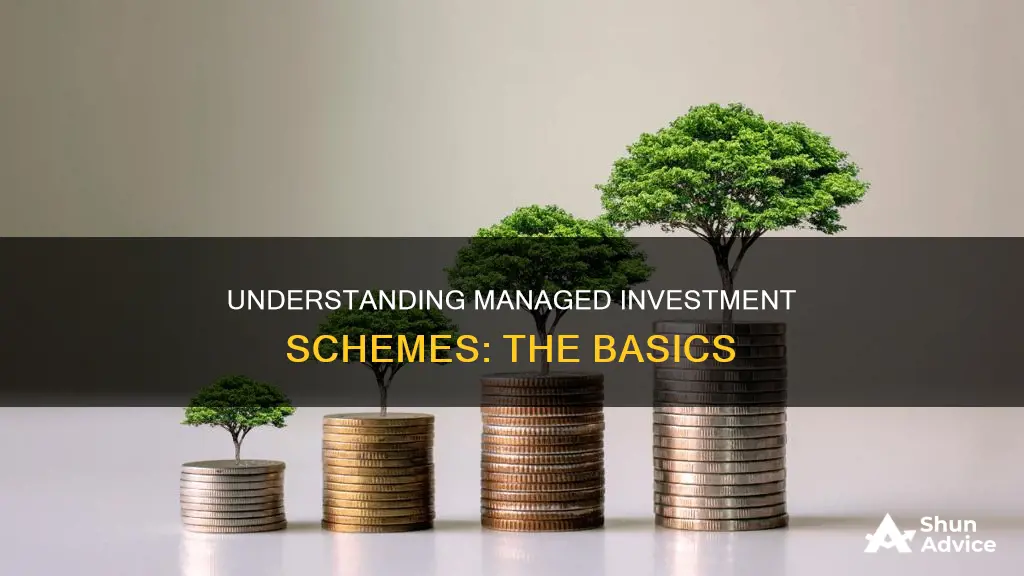
A managed investment trust (MIT) is a type of trust in which members of the public collectively invest in passive income activities, such as shares, property, or fixed-interest assets. The Australian Taxation Office (ATO) outlines the requirements for a trust to qualify as an MIT, which include having an Australian resident trustee and being a managed investment scheme. The term 'managed investment scheme' (MIS) is defined in the Corporations Act 2001 and is regulated by the Australian Securities & Investments Commission (ASIC). MITs are generally taxed under the trust provisions in Division 6 of the Income Tax Assessment Act 1936, and beneficiaries are typically taxed on their share of the net income.
| Characteristics | Values |
|---|---|
| Type | Trust in which members of the public collectively invest in passive income activities |
| Investments | Shares, property or fixed-interest assets |
| Trustee | Australian resident or the central management and control of the trust is in Australia |
| Trading business | Does not carry on or control an active trading business |
| Trust type | Managed investment scheme |
| Widely held requirement | Yes |
| Closely held restriction | Yes |
| Regulated entity | Yes |
What You'll Learn

Managed investment trusts (MITs)
A managed investment trust (MIT) is a type of trust in which members of the public collectively invest in passive income activities, such as shares, property or fixed-interest assets. MITs are publicly held and commercially operated.
For a trust to qualify as a MIT, it must meet certain requirements for the income year it is in operation. These requirements are designed to ensure that a MIT is a genuine collective investment vehicle and to limit the ability of foreign residents to adopt trust structures to access concessional withholding tax rates. The requirements include:
- The trustee is an Australian resident, or the central management and control of the trust is in Australia.
- The trust does not carry on or control an active trading business.
- The trust is a managed investment scheme.
- The trust meets the widely held requirement.
- The trust meets the closely held restriction.
- The trust is operated or managed by an appropriately regulated entity.
MITs (and their members) are generally taxed under the trust provisions in Division 6 of the Income Tax Assessment Act 1936 (ITAA 1936). Under these provisions, beneficiaries are taxed on their share of the net income of a trust, or the trustee is taxed on their behalf, based on the 'present entitlement' of beneficiaries to trust income.
Managed investment trusts include cash management trusts and managed funds, such as a property trust, share trust, equity trust, growth trust, imputation trust or balanced trust.
Unit Trust: Managed Investment Scheme Explained
You may want to see also

Attribution managed investment trusts (AMITs)
In 2016, the Australian Government introduced new laws that changed the taxation of Managed Investment Trusts (MITs), particularly concerning tax-deferred income. This led to the creation of a new trust structure, known as an Attribution Managed Investment Trust (AMIT), which has new tax implications for investors.
A trust qualifies as a MIT if the following apply for the income year in which it operates:
- The trustee is an Australian resident, or the central management and control of the trust is in Australia.
- The trust does not carry on or control an active trading business.
- The trust is a managed investment scheme.
- The trust meets the widely held requirement.
- The trust meets the closely held restriction.
- The trust is operated or managed by an appropriately regulated entity.
To become an AMIT, the trustee must make a choice to apply the new tax system. This means the MIT will be treated as a fixed trust for income tax purposes. The eligibility requirements for an AMIT include:
- The trust is a MIT in relation to the income year.
- The members of the trust have clearly defined rights to income and capital of the trust at all times when the trust is in existence during the income year.
- The rights of all members to income and capital arising from the membership interests in the trust are 'clearly defined'.
The new tax system for AMITs allows them to use an attribution method of tax, carry forward under- and over-estimates of tax amounts, and make adjustments to the cost base of their unit holdings to eliminate double taxation. It also introduces an arm's-length rule to ensure transactions between related entities are conducted fairly, and amends the 20% tracing rule for public unit trusts.
Millennial Money: Strategies for Smart Investment Management
You may want to see also

Passive income activities
A managed investment trust (MIT) is a publicly-held and commercially-operated collective investment trust that invests in primarily passive income activities. Passive income is money earned from sources other than a traditional job, requiring little time or effort.
- Rental properties: Renting out properties, either short-term or long-term, can provide a steady income stream.
- Real estate investment trusts (REITs): These are companies that own and manage real estate, providing an opportunity for investors to gain exposure to the real estate market without direct property ownership.
- Dividend-paying stocks: Shareholders in companies with dividend-yielding stocks receive regular payments, and this form of income is considered passive as it is not related to any active participation.
- Peer-to-peer lending: Individuals can lend money to others through online platforms and earn interest, with returns ranging from 4% to 12%.
- Bonds and bond funds: These are considered passive income sources as they provide a predictable income stream with lower risk compared to stocks.
- Online courses: Creating and selling online courses can be a passive income stream, although it requires significant upfront effort.
- YouTube content: Creating content on YouTube can generate income through ad revenue, sponsorships, and affiliate marketing.
- Affiliate marketing: Promoting products and earning commissions on sales through websites, social media, or email lists is a form of passive income.
- Selling stock photos: Photographers can sell their images online through stock photo websites and earn royalties, although this market is highly competitive.
These are just a few examples of passive income activities that a managed investment trust may engage in. The specific activities will depend on the trust's investment strategy and objectives.
Bankruptcy: Impact on Your Investment Portfolio Explained
You may want to see also

Tax implications
Managed Investment Trusts (MITs) are a type of trust where members of the public collectively invest in passive income activities, such as shares, property, or fixed-interest assets. MITs are generally taxed under the trust provisions in Division 6 of the Income Tax Assessment Act 1936 (ITAA 1936). Under these provisions, beneficiaries are typically taxed based on their share of the net income of the trust, or the trustee is taxed on their behalf, depending on the beneficiary's "present entitlement" to trust income.
On May 5, 2016, the Australian government enacted changes to the taxation of MITs. Eligible MITs can now choose to follow new rules for income years starting on or after July 1, 2015. Once a MIT elects to follow the new rules, the trust provisions in Division 6 no longer apply. These MITs are then referred to as Attribution Managed Investment Trusts (AMITs) and are generally taxed under Division 276 of the Income Tax Assessment Act 1997 (ITAA 1997).
The new tax system also brought changes for MITs in general, including amendments to the rules regarding withholding and non-arm's length income. Additionally, the law now includes changes to the tax treatment of certain corporate unit trusts and public trading trusts due to the repeal of Division 6B of the ITAA 1936 and adjustments to the 20% tracing rule in Division 6C of the same Act.
When it comes to tax returns, individuals must declare any income or credits received from trust investment products. This includes income and capital gains from a trust, capital gains or losses when disposing of MIT units, and any applicable tax offsets. Credits can be claimed for taxes paid on or withheld from trust income, fund payments from a managed investment trust, and trust income subject to foreign resident withholding or non-resident withholding tax.
There are special rules regarding deductions for prepayments of $1,000 or more in relation to managed investments. Additionally, deductions cannot be claimed for expenses incurred in deriving exempt income or non-assessable non-exempt income, nor for amounts already claimed or claimable only by the trust.
Capital gains distributions from trusts can include non-assessable payments, which primarily impact the cost base of units in a unit trust but can sometimes result in a capital gain. In such cases, the trustee should advise whether the CGT discount, the small business 50% active asset reduction, or both, have been considered in calculating the trust's net capital gain.
Investment Managers: Crafting Your Portfolio for Success
You may want to see also

Eligibility requirements
I am unable to generate an answer as there are no relevant documents to create a response.
Understanding the Magic of Compounding in Your Investment Portfolio
You may want to see also
Frequently asked questions
A managed investment trust (MIT) is a publicly-held and commercially-operated collective investment trust that invests in primarily passive income activities. MITs are taxed under the trust provisions in Division 6 of the Income Tax Assessment Act 1936.
A trust qualifies as a MIT if the following requirements are met for the income year in which it operates:
- The trustee is an Australian resident, or the central management and control of the trust is in Australia.
- The trust does not carry on or control an active trading business.
- The trust is a managed investment scheme.
- The trust meets the widely held and closely held requirements.
- The trust is operated or managed by an appropriately regulated entity.
You must show any income or credits received from any trust investment product in your tax return. Your distribution advice or statement from the trust will show the information you need to complete your tax return.
Managed investment trusts include cash management trusts, managed funds (such as a property trust, share trust, equity trust, growth trust, imputation trust, or balanced trust), and corporate unit trusts.







